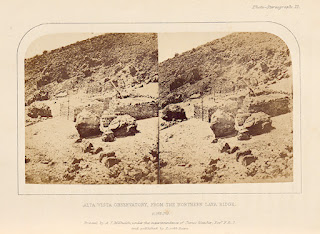Jessica Duncan Smyth is not the first woman known to have climbed Mount Teide. According to Canary Island historians she may have been preceded by a Scottish lady whom they simply refer to as Mrs. Hammond, believed to have crossed paths on the volcano with another expedition organised by the Prussian geologist Leopold von Buch in 1825. But Jessie, as everyone knew her, did belong to that unique and distinguished category of 19th century British women who made their name travelling the world in search of knowledge, adventure and, on occasions, romance.
Jessie came to Tenerife in 1856 to accompany her famous astrologist husband, Charles Piazzi Smyth.
The purpose of the expedition was to
assess the potential of the island’s high mountains for an astronomical
observatory. But as well as scientific, it was also a romantic adventure
because they were just married. Their honeymoon, in fact, became a voyage to the island
on the yacht Titania, as well as a
prolonged stay on the island of Tenerife, sixty five days of it spent on Mount
Teide. Jessie was one of the first women to have been a member of a scientific
expedition of such importance and her role marked a turning point in
the history of the islands during the 19th century.
The Titania was a
magnificent schooner. She was launched in 1853 and was the second of the same name to belong to Robert Stevenson, the great 19th century engineer. He put the yacht at the disposal of his fellow scientist for the entire duration of the expedition to Tenerife. Stevenson, of course, was a man of immense wealth
but he was extremely generous with it. Sadly he suffered ill health for many
years and died while sailing on his beloved Titania
in Norwegian waters just three years after lending it to his astronomer friend.
The Titania, illustrated by Annie Chapman in "New Year on Piazzi's Mountain"
(a story in The Skipping Verger and Other Tales)
In Tenerife Jessie met Mr. Alfred Diston, a British
merchant in the Orotava Valley who always saw to it that British visitors were
well received. Through him she also became friends with Elizabeth Murray, the artist and writer
who had been in Tenerife for six years due to her husband’s consular position.
But Jessie, whose father, lawyer Thomas
Duncan had also been an artist, was not going to accept the comforts and
company provided by the small and distinguished British community. She had studied geology in Edinburgh and her
love of adventure and scientific travel was equal to Piazzi's.
Jessie became a very important member of her husband’s
scientific expeditions. She always kept notes and made sketches for their
adventures and learned to prepare and to preserve local foods. Amongst
other activities she acted as photographer for the astronomer’s team. Indeed her
stereoscopic prints were the first to have been published alongside text in a
book and her work is considered of pioneering value.
Their first observation point was on Mount Guajara
On Mount Teide a walled enclosure provided shelter for the Piazzi's telescopes, as well as for the honeymoon couple and companions.
This is what George Graham Toler later developed into the Alta Vista mountain refuge.
It was thanks largely to the novelty of including twenty of Jessie’s stereoscopic reproductions in Charles Piazzi Smyth’s book, Teneriffe: an Astronomer’s Experiment or Specialities of a Residence above the Clouds, that it was accepted for publication in 1858.
Piazzi's account of his experiments in Tenerife.
After Tenerife the husband and wife team travelled to
Russia and in 1864 the couple spent a year in Egypt. Jessie and Charles Piazzi
Smyth lived four months under canvas whilst carrying out investigations into
the Great Pyramid of Giza. Jessica’s photographs, inside and outside of the
pyramid, were essential for backing up her husband’s work. Actually her
photography in Tenerife only found limited recognition in the British Isles, but
Canary Island historians consider Jessie Duncan Smyth’s work most important.
After all, she was the first to have photographs of their islands printed in
books. Therefore she is one of those early travellers who helped put Tenerife
on the map, especially in scientific circles, and to have turned the
spectacular mountains of Tenerife into a prime destination for any explorer. Some of her photographs of the interior of Teide’s ice cave captured the imagination of many explorers and early visitors to the island. The domed cave hid a beautiful icy lagoon with the purest water to be found, and icicles and stalactites hung in it like fragile works of art.
A photograph taken in 1927 inside the ice cave.
The
islands today are considered one of the world’s best locations for astronomic observations and there is no doubt that the Canary Islands Astrophysics
Institute, with its Tenerife centre at Izaña, owes much to Charles and Jessica
Piazzi Smyth’s expedition in 1856.
The Mount Teide Astrophysics Institute at Izaña.
The couple retired to North Yorkshire where
Jessie Piazzi Smyth died in 1896, aged 81. There is an interesting,
pyramid-shaped monument to the couple in the churchyard at St. John's Church at
Sharow. It is a pleasant thought that they took their romantic adventures in Tenerife and Egypt with
them to the grave.
The unusual pyramid where the scientific and romantic adventurers, Charles and Jessie, lie at rest.
(Certain images have been reproduced from internet with no personal financial gain intended.)
By John Reid Young
Author of The Skipping Verger and Other Tales, a collection of short stories set in Tenerife.







